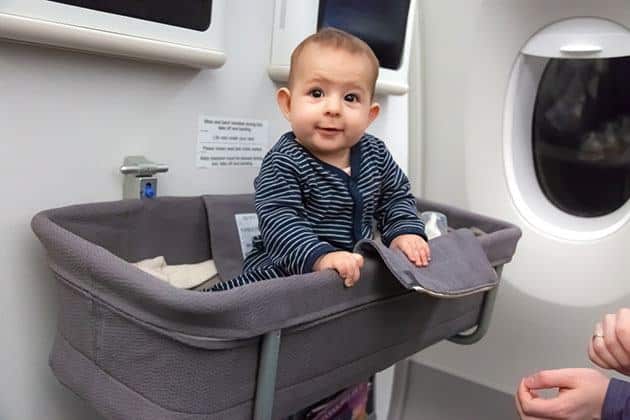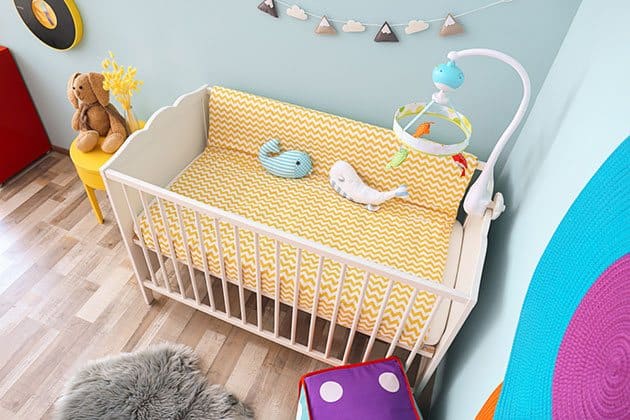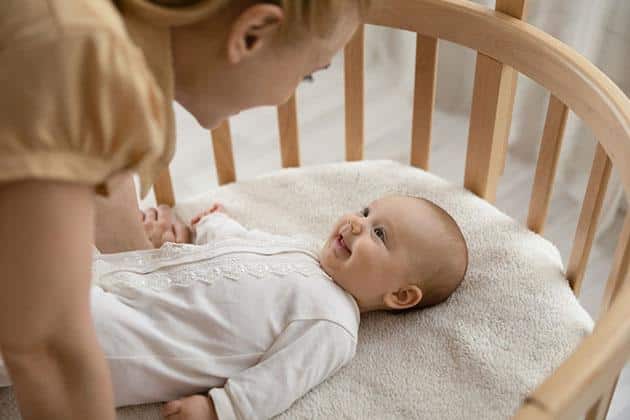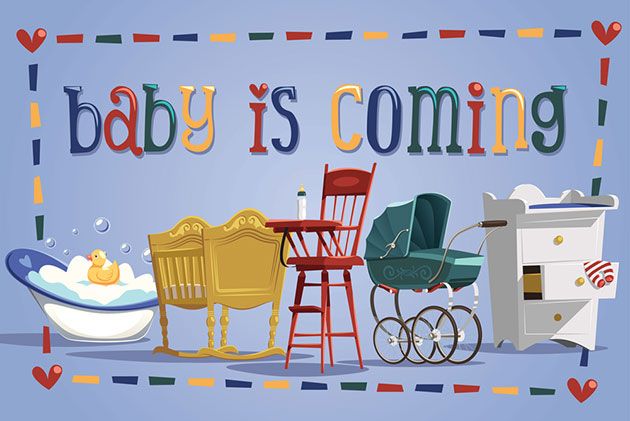The final baby preparations are here, and it's time to furnish the nursery! Choosing among various cribs, bassinets, changing tables, and baby rockers can be overwhelming.
You might be wondering:
Do you need all of them for your baby's first months, or do they only serve a decorative purpose?
While some parents opt for traditional cribs, others lay their trust in bassinets. Whether you are welcoming a baby into your family or debating on a baby shower present, you are in the right place.
Along with professional medical advice, this guide will help you decide between a bassinet vs crib and the safest sleeping arrangement based on your budget and room size.
More...
What is a Baby Bassinet?

A bassinet is a baby sleeping furniture, typically oval-shaped, suitable for newborn to four-month-olds. Its portable is one of the biggest benefits for busy parents.
Traditional bassinets were usually fixed to the frame. However, the modern design was altered for the better. Now, the bassinets offer soothing motions that put your baby to sleep.
Benefits of Using Bassinets
When Not to Use Bassinets
What is a Baby Crib?
A crib is a fixed or portable child bedstead with high slats, suitable from birth to three years old. With wooden or metal frame fixtures, cribs offer a better longevity choice. Some can even convert into toddler beds after your little one is grown up.
Just like bassinets, cribs are also suitable for room sharing. You should keep them in the nursery at least for the first six months of your baby's life.
Types of Cribs

There are various crib types you can choose based on personal preference:
- Traditional crib: This type of crib is of a typical rectangular shape and is made of wood. If you embark on a DIY project, you can accommodate a standard crib to fit a small space!
- Convertible cribs: As the name suggests, convertible cribs can be easily altered to fit the growing stage of a baby. By getting a convertible crib, you are initially supporting independent sleeping in the future.
- Mini-cribs: A mini-crib resembles a bassinet style the most. It's smaller than the other types but takes up less space. It's also a great choice if you have twins and want to avoid purchasing two full-size cribs! However, these cribs often have smaller weight limits. You can't use mini-cribs for a long time, despite their practicability.
- Round crib: Although the oval shape is modern, it's not very practical. A round crib fits awkwardly into any room, costs a lot of money, and requires an oval mattress.
- Combo-crib: A combo-crib is a great way to save space in your nursery! These cribs come with an integrated changing table.
- Travel crib: Travel portable cribs are excellent when visiting relatives or traveling with a baby. A travel crib is usually made from a flexible mesh material that folds with ease!
- Pack N' Play: The crib is made from mesh sides that promote air circulation. This type of crib acts as a play yard and is an exception during summer.
Benefits of Using Cribs
When Not to Use Cribs?
Bassinet vs Crib: Which One is the Safer Option?
The American Academy of Pediatrics (AAP) report states that both cribs and bassinets offer safe sleep accommodations for newborns.
Whether you choose either a freestanding crib or a bassinet, make sure you do not install them as a co-sleeping device. A baby must share the room with the caregivers for the first six months. After that, however, sharing a bed or co-sleeping should be avoided!
Tips & Safety Guidelines to Create a Safe Sleep Space

According to the AAP, these are a few safety considerations for creating a safe sleeping environment:
- The sleeping baby must always lay on its back, never on the side or facedown! The supine position should be followed at least until the baby is one year old. It decreases the risk of choking and SIDS.
- A bassinet and a crib need to have a firm sleeping surface. This type of surface will not create an indentation for the head and neck. Memory foam mattresses should be avoided as they often change form. Only use a specified mattress that meets safety standards and fits a bassinet and a crib.
- When fitting a mattress, ensure no loose spots or extra space. Carefully measure interior dimensions before purchasing, and don't use pillows or cushions as additional support.
- Infants should not be sleeping on an adult bed or a bed with rails. The rail design increases the risk of suffocation and strangulation.
- Other baby sleeping devices such as car seats, carriers, strollers, and similar should not be used as a home sleeping accommodation.
- Breastfeeding is known to lower the chance of SIDS by 50%. Breastfeeding should be included throughout the first six months, while formulas and other supplements should be avoided if possible.
- No loose items should be included in the bassinet or the crib. Objects such as stuffed animals, crib bumpers, pillows, or loose blankets can disrupt the baby's sleep and risk suffocation.
- Avoids using a sleeping aid like sleep positioners.
- Room sharing is advised. A portable crib or a bassinet keeps the baby close.
- Avoid covering the baby's head and overheating. If your baby tends to roll over during the night, do not swaddle.
How to Choose Between a Bassinet vs Crib?
Both a bassinet and a crib are excellent sleeping accommodations for the infant. It can be challenging to pick the right one with its many advantages.
Eventually, it all comes down to three considerations: budget, baby's size, and the size of the sleeping furniture.
Budget
Bassinets are cheaper than cribs.
However, bassinets have limited use. While you can use a bassinet for around six months, you can get at least two years of service from a crib.
As a result, many parents tend to go straight for the crib, which they can later turn into adult beds.
Standard cribs will cost you more, but consider them a life-long investment!
Baby's Age & Weight
A bassinet can only be used for a few months, while a crib can follow the baby's development much longer. For this reason, you will always need to check the weight recommendations on baby products.
Many bassinets make babies feel comfortable due to the smaller space. Plus, bassinets do not take up plenty of room in the nursery. When your newborn reaches 15 pounds, it's time to switch to something bigger!
Bassinet vs Crib Size
As mentioned above, most bassinets are usually smaller than cribs. So before you invest in either of them, check whether you have enough room. Luckily, cribs come in different types, so you can easily find a compact portable crib that fits a small space.
FAQs
Do you need both a bassinet and crib?
No, it's not necessary to have both a bassinet and crib.
Bassinets are suitable for use from birth to approximately 4-6 months. Cribs offer a longer use and can often be altered to an adult-sized bed.
How long should a baby stay in a bassinet?
The American Academy of Pediatrics recommends babies use a bassinet for the first six months. After that, your baby might outgrow the bassinet, so you must always check the weight and height limit.

Should newborns sleep in a crib during the day?
Yes, a newborn can sleep in a crib during the day. By allowing them to nap in the crib, they will get used to the sleeping accommodation and develop their sleeping pattern.
However, checking whether the crib mattress is safe for infants and newborns is necessary.
Can newborns sleep in a crib?
Newborns can sleep in a crib with a good mattress. Therefore, sharing a room with the baby is highly recommended during the first six months of their life. However, a crib should never be attached to the parent's bed or should you use sleeping aids.
A newborn must get used to independent sleeping, and cribs are the safest way of ensuring they do.
Is the bassinet safe for night sleeping?
A bassinet is safe for night sleeping as long as they are appropriately regulated.
For example, when putting a baby in a bassinet, ensure he is laying on the back, never on the side or face down! Also, objects such as toys, rattles, and pillows should never be in a bassinet.
Why is SIDS risk higher at 2 months?
SIDS risk gets higher after the second month due to cardiorespiratory development. The newborn's system is still developing and is unstable, which can lead to uncontrolled breathing.
However, one of the most common factors of SIDS is stomach sleeping and environmental changes.
Final Words
Cribs and bassinets are one of the best sleeping accommodations for keeping the baby safe.
In your upcoming parenting journey, you might face some challenges regarding smart investing. If you still have doubts about choosing bassinets or cribs, check the three factors discussed above.
Whichever option you choose, you will not go wrong.
